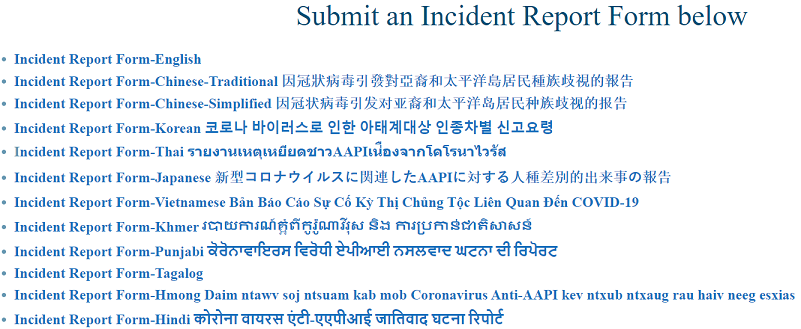Reimagining Activist Data: A Critique of the STOP AAPI HATE Reports through a Cultural Rhetorics Lens
by Dan Harrigan | Xchanges 16.1, Spring 2021
Contents
Outlining the STOP AAPI HATE Initiative
Linking the STOP AAPI HATE Reports and Cultural Rhetorics
Assembling a Cultural Rhetorics Methodology: Decolonial, Indigenous, and Feminist Theory
Critiquing the STOP AAPI HATE Reports
Reimagining Future Options for STOP AAPI HATE Data
Imagining a Cultural Rhetorics-Informed Future for Technical Communication
Outlining the STOP AAPI HATE Initiative
Purpose and Impact
Before examining the myriad connections between the STOP AAPI HATE summative reports and the field of cultural rhetorics, I will introduce the initiative’s specific purpose and involvement within AAPI communities. In response to the rising amount of anti-AAPI rhetoric within the U.S., the California-based Asian Pacific Planning and Policy Council (AP3CON), Chinese for Affirmative Action (CAA), and San Francisco Department of Asian American Studies launched The STOP AAPI HATE website on March 13th, 2020. The website serves as a reporting center for anti-AAPI violence, offering AAPIs the opportunity to submit digital “incident reports” (or personal accounts) to share and make visible their experiences. According to Choi and Kulkarni (2020), the STOP AAPI HATE digital reporting center aims “... to collect and track incidents of anti-Asian American and Pacific islander hate... in California and throughout the country. The reporting center will enable individuals ... to share their stories” (para. 1).
As of May 2020, two months since the site’s initial launch, affected AAPIs have already submitted nearly 1,500 stories to the STOP AAPI HATE initiative. Using these stories as data, the initiative has produced three technical summative reports, which feature incident report data trends and selected AAPI accounts, over that time span. According to Choi and Kulkarni (2020), “... the collected data will allow [STOP AAPI HATE] to assess the extent and magnitude of these incidents and to develop strategic interventions” (para. 3). Considering both its short-term purpose (AAPI story sharing) and long-term goals (policy changes to combat AAPI racism), it is clear that the STOP AAPI HATE initiative is residing in an intriguing activist niche, with its technical, data-driven summative reports advocating for AAPI justice in these uncertain times.
Incident Report Forms
Since the sharing of stories is central to the STOP AAPI HATE objective, it is necessary to briefly outline the incident report submission process. As of May 2020, the incident reporting form is available on the main STOP AAPI HATE website via drop-down menu or click-through link. The forms are digitally accessible in 12 different languages, and the form itself presents the submitter with various required response prompts using Google Forms. For reference, Figure 1 shows a screen capture of the main reporting site, while Figure 2 shows a section of the incident reporting form (in Korean).


The reporting form requires the user to supply personal identifying information, such as first and last name, ethnicity, age, email address and city/state location (which, per the initiative, is kept confidential). The user is then required to supply the date/time of the incident, classify the type of incident, and provide a concise account of the incident. Once the form is submitted, the user is taken to a screen that thanks them for their submission and gives them an opportunity to edit their response. Upon clicking out of that screen, the user officially completes the incident report submission process. With nearly 1,500 submissions received as of May 2020, the initiative does caution that it will not be able to address or reply to all received submissions. Interestingly, the user is not sent an email confirming their submission, despite being required to provide their email address. The initiative presumably stores the user-submitted incident reports in a digital database before collating said submissions in its end deliverable: the STOP AAPI HATE summative report.
Summative Reports
The STOP AAPI HATE summative report is a technical document that primarily serves to convert a specific time period’s submitted incident report forms into statistical data, using tables and graphs to visualize incident trends. Additionally, the summative report publishes selected AAPI stories, chosen from that time period’s received forms. Each summative report can be broken down into three central components: a press release section that lists the most prevalent trends from that week’s incident reports, tabled or graphed data gathered from incident report responses, and categorized AAPI stories. Highlighting a particular summative report—covering dates from March 19th to April 15th, 2020—as an example, one can see how the STOP AAPI HATE initiative chooses to interpret data from the submitted incident report forms. In the “press release” section, the initiative highlights specific data trends within the report, consistently referring to the number of received incident submissions while comparing the newly collected data to previous summative reports (Figure 3).

In the “tabled/graphed data” section, the initiative illustrates the statistical data gleaned from the incident report forms, charting the different sites, reasons, and types of anti-AAPI discrimination using percentage tables and simple bar graphs (Figure 4).

Interestingly, the initiative switches to a pie graph visual when charting the ethnicities, ages, and locations of incident report submitters, presumably because of the abundance of options (Figure 5).

Finally, in the “AAPI stories” section, the initiative highlights around 20 specific incidents of AAPI discrimination per summative report, categorizing these stories by their specific type of discrimination (Figure 6).

Although non-English options exist for incident reporting submission, it is unclear if non-English versions of the summative reports are available for public viewing. Ultimately, given these descriptors and due to their use of statistical data to convey information clearly to stakeholders invested in AAPI issues, the STOP AAPI HATE summative reports can be considered as technical communication documents.
 Download PDF
Download PDF